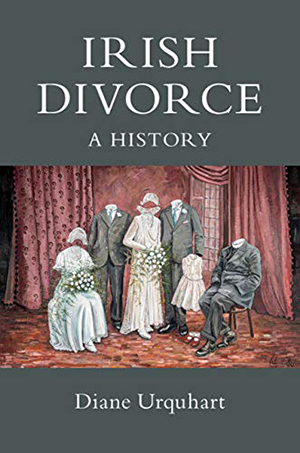IRISH DIVORCE: a history
Published in Book Reviews, Book Reviews, Issue 5 (September/October 2020), Reviews, Volume 28DIANE URQUHART
Cambridge University Press
£22.99
ISBN 9781108717250
Reviewed by Mary Kenny
Mary Kenny is a founder member of the Irish Women’s Liberation Movement and author of Goodbye to Catholic Ireland (New Island Books, 2000).
 Historically, there has seldom been any great ‘clamour’—as Professor Diane Urquhart puts it—for divorce in Ireland. Although the Brehon laws did, apparently, allow the dissolution of marriages in some instances, it was infrequent and class-bound. Irish divorce in ancient times was often about family power—and wealth.
Historically, there has seldom been any great ‘clamour’—as Professor Diane Urquhart puts it—for divorce in Ireland. Although the Brehon laws did, apparently, allow the dissolution of marriages in some instances, it was infrequent and class-bound. Irish divorce in ancient times was often about family power—and wealth.
And that’s how things broadly stayed until the mid-Victorian era. In Britain, as in Ireland, divorce was difficult to obtain, stigmatising within society and only available to the wealthy and aristocratic. (We pass over, as does Prof. Urquhart, the case of Henry VIII, for whom divorce was an alternative to beheading.) Even where feasible—and then only through the channel of parliament—divorce imposed a double standard on men and women. A wife’s adultery was always seen as a more serious offence than a husband’s, probably because of the risk of introducing illegitimate heirs into aristocratic lineage, although this certainly happened—Lord Melbourne’s paternity, for example, was ambiguous. Until the brave Caroline Norton began her campaign for mothers’ custodial rights, women often cruelly lost access to their children in divorce or separation—a situation which could obtain until relatively recently. A friend of mine, divorced in a Scottish court in the 1960s, lost child custody when the judge branded her ‘an adulteress’.
In 1857 Britain began cautiously re-addressing the divorce question with a Divorce and Matrimonial Causes Bill, partly prompted by an early campaigner, Lady Westmeath, a victim of infidelty and domestic cruelty. In 1885 Lady Louise Westropp was the first Irishwoman to obtain an Irish divorce via the court of chancery.
Yet whenever divorce law arose at Westminster, Ireland was always excluded. There was an understanding that divorce wasn’t popular among the Irish—Catholic or Protestant—and an interesting belief, endorsed by the Irish themselves, that Ireland was matrimonially ‘purer’. The truth was that, what with famines, land wars, evictions and the penal laws’ long shadow, most Irish people probably had other concerns than whether some swell could dissolve his marriage. Daniel O’Connell was against divorce. William Gladstone was against divorce, and praised Ireland’s lack of it. (It transpired that Edward Carson was also against divorce.)
Then came Parnell and his relationship with Katharine O’Shea, which led to that sensational divorce, deplored first by Michael Davitt, then by the Methodist Evangelicals and subsequently by the Catholic Church. All this scuppered any consideration of divorce reform, besides its effect on the fate of the Irish Parliamentary Party.
Britain gradually moved towards more divorce accessibility, from parliament to the matrimonial division of regular courts. Ireland, North and South, remained reluctant, though Stormont finally passed an act in 1938. Much is made of the Free State’s ban on divorce from 1925 but, despite Senator Yeats’s famous protest, the prohibition broadly represented the values of the electorate.
Things began to shift in the 1960s and ’70s, with a constitutional review, the European Court facilitating claims of individual rights and Vatican II prompting more decisive separation between Church and State. In 1973 the ‘special position’ of the Catholic Church was dropped from the constitution. Garret Fitzgerald suggested making divorce available: there were many anomalies as regards Irish citizens—such as Conor Cruise O’Brien—who had obtained a British divorce. From 1969 more liberal divorce spread internationally and there was a gradual campaign under way in Ireland. And yet there was still wariness, and many women remained anti-divorce—including the Anglican Mothers’ Union—since they often saw it as an opportunity for an errant husband to discard an older wife for a younger model.
Urquhart expresses disappointment that the Irish Women’s Liberation Movement did not include divorce in our 1971 manifesto ‘Chains or Change’. I was one of the authors of this pamphlet, and the omission of divorce was shrewdly judged. Deserted wives, justice for widows, contraception, jury service, access to financial services without a male counter-signature, fair treatment in mortgages and housing were greater priorities. Most women, as Urquhart’s evidence shows, would not support divorce: wives’ property rights were weak, and a divorce could leave a woman without a roof over her head. Other family law reforms were required first. Irish divorce finally squeezed past the electorate in 1995 by half of one per cent.
Professor Urquhart’s study is a meticulous, detailed record of Irish divorce, and a necessary telling of the legal path to change, but more social context could have been illuminating. The Irish reluctance concerning divorce should be set against the persistant Irish reluctance—since the Famine—to marry. From the mid-nineteenth century to the 1960s, anything up to a quarter of the population remained single. There was continuing lamentation about the shrinking population owing to low matrimonial rates.
Falling marriage statistics are again a feature of Irish life, and among the poorest sectors of society no marriage has become the norm, replaced by variable terms of cohabitation. Professor Urquhart seems unwilling to acknowledge the conservative case for durable marriage: but since poverty, relationship instability and low educational achievements among children are often associated with an absence of parental marriage, it is not unreasonable to believe that there is still something to be said for committed wedlock.
















